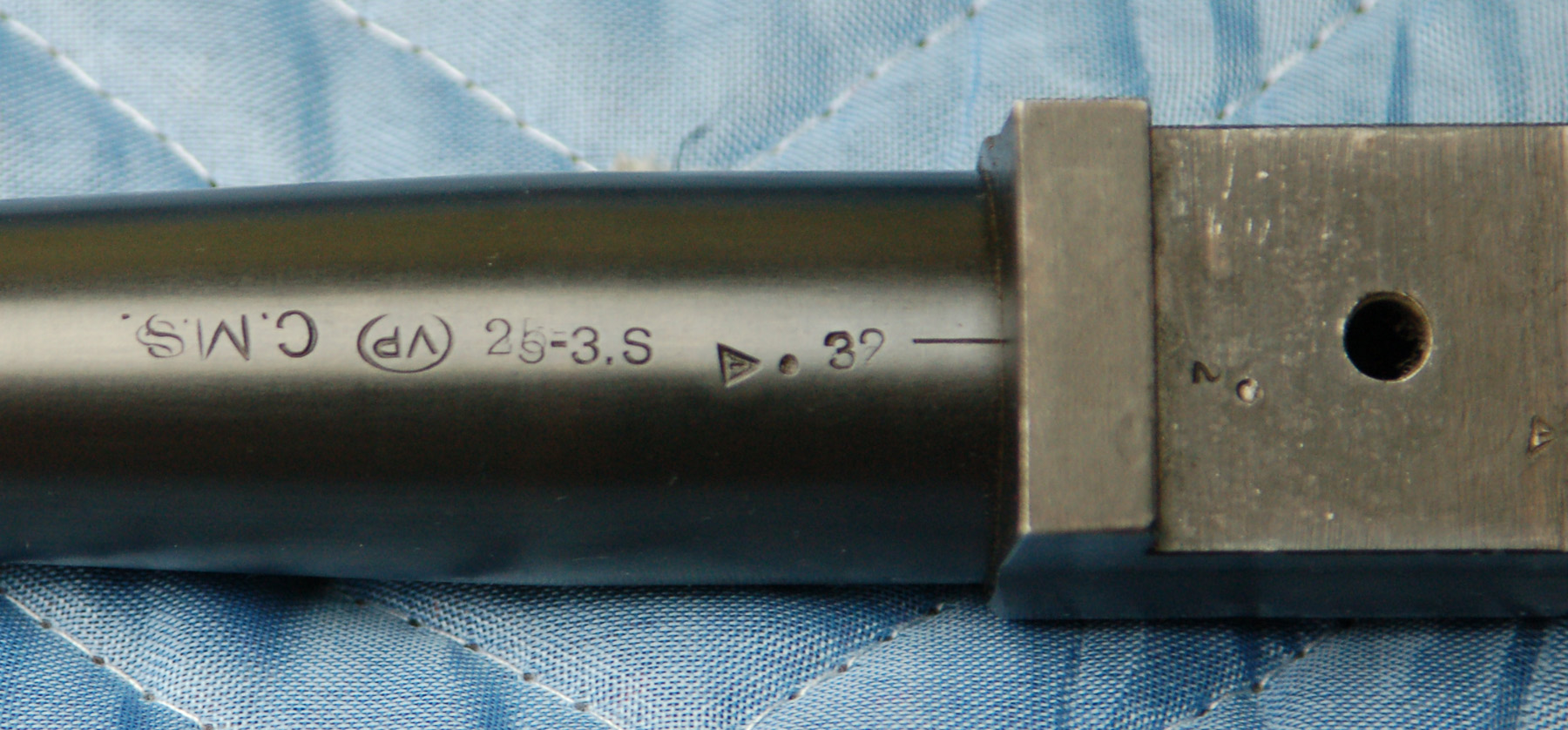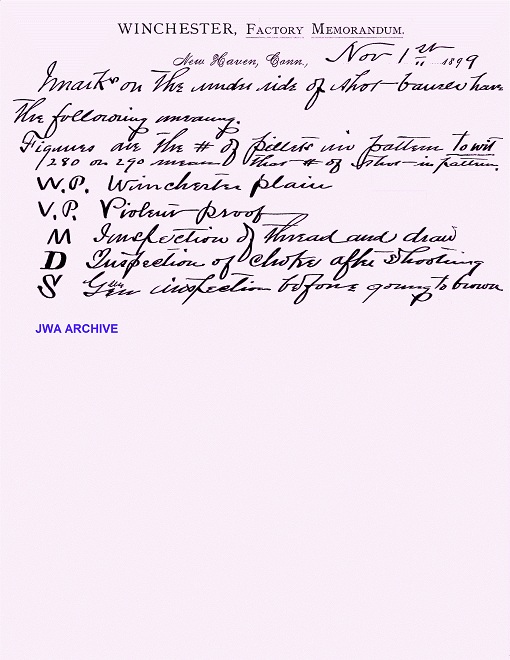November 5, 2014
 Offline
OfflineAll-
Here’s a bit of a trivia question… What does the hand stamp of ‘VP’ in an oval mean on a M70 barrel? I am puzzled???
The rifle is a 1937 (s/c 13532) M70 Standard Grade with 20 inch barrel (a.k.a. “Carbine”) in 250-3000 SAVAGE. It has been in our hands a long time (but not since ’37!!!!). As you can see, the barrel date is ’32, which makes it a Chrome Moly Steel M54 barrel blank (in a slow selling caliber) that found it’s way onto an early M70.
The under barrel markings are: C.M.S. (chrome moly steel); ‘VP’ in oval (????); 25-3.S (caliber designation); triangle-dash (inspector mark); hardness dot; 32 (year blank was made); – (index mark).
The ‘VP’ thing beats the heck out of me. I have read on this site that ‘VP’ designates “violent proof”. But I am under the impression that the under barrel markings on M70 barrels were applied before the barrels were ever polished (and long before they were fit to an action, final headspaced, and proofed).
The reason that the exposed ‘WP’ proof on Winchesters is rough and shows bare metal is that it was applied after all these steps. The ‘VP’ stamp in the photo above seems to me to have the typical ‘partly polished out’ appearance of a stamp applied before the barrel was polished. So how does one “violent proof” a barrel before the final chamber is cut? And why have a concealed ‘VP’ proof mark and a typical exposed ‘WP’ proof mark?
My suspicion is that the ‘VP’ mark (in the case of 1930’s M70 barrels) must mean something else. But I have no clue. Anyone have either the facts or a good theory???? 
Thanks,
Lou
WACA 9519; Studying Pre-64 Model 70 Winchesters
![]()
Lou,
After we talked I did some more digging. Roger Rule (M70 book, page 9, Photo Caption 1-9) pictures a Model 54 barrel with the “VP” stamp and identifies it as: “the initials of the barrel maker.” I have seen this claim elsewhere too.
On several Internet forums there is reference to the Winchester VP stamp–variously labeled as “Viewed Proof,” “Proof Veritas,” or “Violent Proof.”
On M70 barrels, the VP stamp is very rare–and maybe only found on, Pre-1936 M54 barrels that morphed into M70s. I understand the stamp is common on many of the lever actions.
I agree with your reservations about the proofing process and the seemingly unlikely proofing of barrels very early in the barrel making sequence. Also, it seems the action is the week link in the pressure chain–do barrels blow up any other time except when they’re plugged?
Lou,
It is my understanding that the “VP” a.k.a. “violent proof” was applied after the barrel was initially bore and fired with a 200% proof load. The following is quoted from one of Winchester’s pre-1900 catalogs.
“How Winchester Barrels Are tested.
Gun makers agree, that the most difficult part of a gun to make is the barrel. To do so successfully, requires a thorough knowledge of the subject, skilled experts, delicate and exact machinery, and a comprehensive system of tests. The system by which Winchester barrels are made has made them famous all over the world for their unerring accuracy and strength. When a Winchester barrel has been “rough” bored, as the first boring is called, it is proved for strength, by the English Government proof system. The barrel is locked to a firing table, loaded with a charge of powder and lead twice as great as could be put into the shell the barrel is to be chambered for, and fired. It is then carefully inspected and if the barrel shows the slightest sign of strain, or imperfection, it is condemned. It is next straightened and then given the second or “finish: boring. It is then straightened again, after which it is subjected to what is known as the “ Winchester ” or “ Lead ” test. This test never fails to disclose any imperfections in the interior of the barrel. In making this test the barrel is held in a vise and a plug of lead the exact size of the bore placed in it at the breech and expanded or “ upset ” until it binds lightly and evenly all around the bore. The plug is then pushed gradually through the barrel with a copper rod by the expert conducting the test. The slightest variation in the diameter of the bore is instantly disclosed by the different pressure required to push the plug through the barrel. This test is repeated after the barrel is rifled, for the purpose of detecting any possible disturbance of the bore during the latter process. Such a test as this is so exacting that no other gun makers attempt it. ” end quote.
Bert
WACA Historian & Board of Director Member #6571L

November 5, 2014
 Offline
OfflineHi Bert-
Any idea when this ‘VP’ process (proofing rough bored barrels) was phased out? I assume it was abandoned at some point? I certainly see it could be important during the transition between black and smokeless powder around the turn of the century. But how much did the factory feel they needed to ‘proof’ Winchester ‘Proof’ Steel once it came along?
As Vic says, I’ve not seen this on a M70 barrel (at least not one ‘made for’ a M70). Rule’s book (I missed photo 1-9 – Thanks Vic) shows the oval VP stamp on a M54 30-06 barrel dated ’26, and the M54/70 barrel I pictured above is dated ’32. An early Chrome Moly (Winchester Proof Steel) barrel (replacing Nickel Steel starting in ’31).
Cheers,
Lou
WACA 9519; Studying Pre-64 Model 70 Winchesters
![]()
Lou,
I do not know exactly when Winchester abandoned the violent proofing method/procedure, but it seems logical that it took place in the early 1930s when Proof Steel replaced the Nickel Steel barrels. In my recollection, I find the oval VP marking on nearly all of the Nickel Steel barrels, and cannot remember seeing it on the later Proof Steel barrels. For the Model 94, the transition between the two barrel alloys took place in April 1932.
Bert
WACA Historian & Board of Director Member #6571L

November 5, 2014
 Offline
OfflineThanks, Bert
That would make sense. I only routinely look at the under barrel markings of M70s, all of which had Winchester Proof Steel (CMS) barrels. The picture in Rule (photo 1-9) showing the VP stamp on a 1926 M54 would have been a Nickel Steel barrel.
If the practice ended around the time the new barrel steel was introduced (circa 1932), then as Vic says the stamp would only be likely turn up on a M70s that were assembled using a leftover M54 barrel blanks (and then perhaps infrequently). Vic mentioned he’d only seen that on one other M70, and it too had a ‘pre-36’ (M54) barrel.
The ’32 barrel I showed above is the earliest barrel date I have on a M70, the next being ’35, ’36, and ’37 – which only have the “expected” under barrel stamps.
Cheers,
Lou
WACA 9519; Studying Pre-64 Model 70 Winchesters
![]()
1 Guest(s)


 Log In
Log In Members
Members Home
Home

 Add Reply
Add Reply Add Topic
Add Topic








